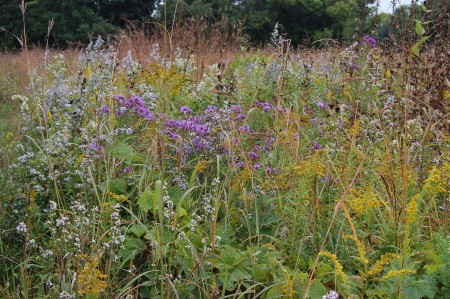About a month ago the leading flag on the ‘flag counter’ on my blog finally tipped from the Union Jack to the Stars and Stripes. So perhaps this is a good moment to reflect on Anglo-American relations in the garden. With the recent visit of Mr. Obama (who we Europeans by the way all adore) there has been yet another spate of politicians and commentators discussing the so-called ‘Special Relationship’. There certainly is one in gardening, and like the political version, it is complex, constantly changing, and sometimes controversial.
During my first few visits to the US (1990s, early 2000s) the special relationship resembled nothing more than a rather quaint colonial hangover. Americans may have flung the tea into Boston harbour in 1773, and then to add insult to injury dropped the ‘u’ from harbour, but so many gardeners seemed to be still so stuck to the English garden as a model. Grande-dames of the UK garden world like Penelope Hobhouse and Rosemary Verey sold vast piles of books to the US. The latter (who remembers her now?) spent Christmas one year with Ross Perot (yes, really, and who remembers him now?)
The English model, all rose-decked, lush green lawned and topiaried, seemed to be the model to emulate. Needless to say, this did not appeal to me; I don’t travel to see my own culture imitated in inappropriate surroundings. It wasn’t just Olde Englande that gets (badly) imitated, classical Italy does too – in fact there are few things that I loathe more than mock-classical pillars infesting a landscape where they so patently don’t belong (which rules out a lot of California).
I remember being in a garden in New England (1994), one of those really really fantastic autumns, having been driven there by an English colleague who kept on driving on the wrong side of the road (by the way I have never yet done this). The garden had been modelled on Madame Verey’s Barnsley House, and I remember thinking …. this just does not belong here, it looks like it’s been airlifted in…. you guys have got a fantastic native flora, far richer than ours, and a massive, varied, epic landscape and you do this!!!!
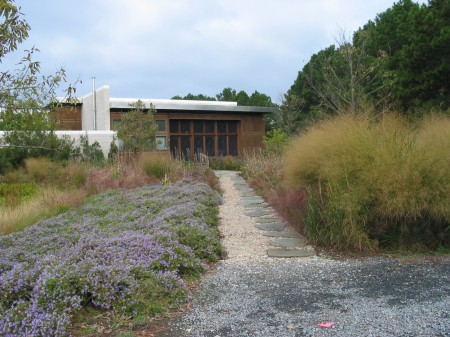
James van Sweden's garden in Maryland - a stylised response to local landscapes helped me to read more into a range of semi-natural habitats in the US, such as appreciating wild grasses along highways.
A later trip (1996) saw me as part of a Horticulture Magazine lecture tour, with James van Sweden, the late Wayne Winterrowd, Bob Procter and Rick Darke. We started off with two gigs in the Midwest. No-one here was very interested in the Olde Englishe garden but instead were very receptive to my talking about naturalistic planting (Dutch and German in origin) which segued into what James van Sweden was doing with Wolfgang Oehme (German by origin). The Midwest has fascinated me ever since, at least the bits that aren’t covered by corn and soybeans (which I can actually appreciate, when in agricultural genetics mode, but that’s a different story). The gentle role of the land, the big skies, the incredible variations in flora wherever there is some nature left.
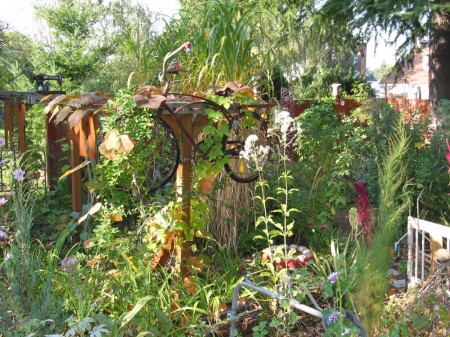
Zany junk gardens - this one is Nancy Goldman's in Portland - good to see people having fun with their gardens, which not enough do over here.
When asked by fellow Brits about “what is the American garden scene like?”, I give a deep sigh and reply “patchy”… which means there are places with an incredible garden culture (like part of Oregon and Washington, San Francisco), those with a lot going on (much of the coastal north-east) and others with only isolated pockets (much of the rest). The USA is not a nation after all but sub-continent; like India, anything you say about it, the opposite is also true. Just as there are in politics, lifestyle and spirituality, there are several very different cultures here – some of them garden and some of them just mow the lawn.
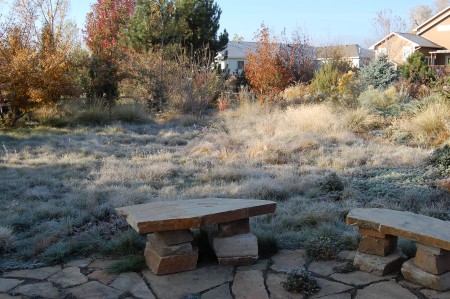
So much better than the mown stuff. A suburban garden grassland on a frosty morning in Colorado - Lauren Springer's garden in Fort Collins.
The great American lawn. Let’s not go there.
One of the really good things over the last twenty years that I have visiting the US (about once every 18 months on average) is that more and more Americans are getting up and denouncing this monstrous thirsty fraud.
And discovering that you can rip it up and replace with some incredible native floras: Neil Diboll of Prairie Nursery and Roy Diblick of Northwind have been two people who have shown, albeit in very different ways, how you can do this. And yet it still lives on, I remember driving from New Orleans to Monroe, LA, wondering why so much effort to grow just flat grass? in a climate where you can practically see plants grow, and how if a family of Vietnamese moved in, they’d be growing enough vegetables to feed the entire neighbourhood in a matter of months.
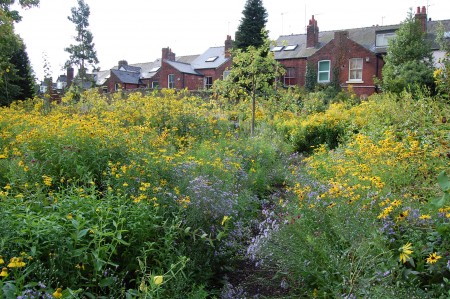
A prairie in the Sheffield Botanic Gardens, northern England, planted by Prof. James Hitchmough (the row of brick terraced houses proves its location) - it makes a great resource for butterflies.
It’s time to look at the other side of the equation, the current interest in prairies which seems to be affecting European gardeners, and which is helping tip the Special Relationship more in the USA>UK direction. I’ve written about this before. Not real prairies of course, but the word is a useful one for those of us who want to do big, expansive perennial and grass plantings, which are wildlife-rich and don’t take too much work; and which incidentally, can to some extent, incorporate our natives too. For those of you who would wish to remind me what I have just said about inappropriate plantings in landscape halfway across the world, what actually appeals to us is that the prairie stuff fits into our landscapes far better than the (mostly) Southern Hemisphere spikies that have become popular over the last few years: phormiums, yuccas, kniphofias. A prairie planting in front of a range of British hills, woods and hedge-divided fields does not look that out of place.
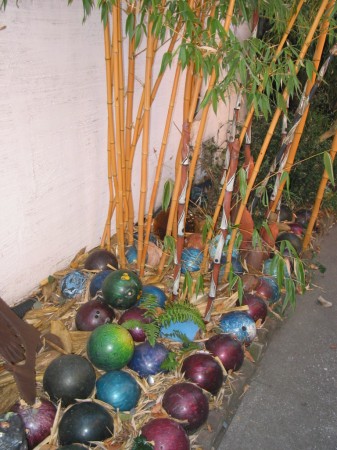
Great Mulch - Marcia Donahue's Bowling Ball Border - from one of the most original garden makers. Berkeley, California.
To go back to the Horticulture Lecture tour …. that included my first trip to Portland, OR, a place I fell in love with and went back, maybe 6 times. I loved it, peopled with the sensible end of the California sixties dream, an incredibly rich, inventive, adventurous and often whacky garden culture. Portland itself was so beautiful and the trams made me feel I was in a well-run European city. But I haven’t been back for years. Somehow I have become someone who lands in New York, hangs out for a couple of days in the district around the Highline (I love the Chelsea Hotel) and then heads out to Chicago. Chicago is so not-Europe, it’s a place where you can feel somewhere that is really different. Its garden culture still feels new and uncertain, but much more locally-rooted and down-to-earth than Portland’s Pacific eclecticism. There are people there who are really making a difference to horticulture public and private, which is important to me: Marcus de la Fleur’s amazing rain-garden house, and landscape architect Terry Guen, to name but two.
So, to sum up, the Special Relationship is much more balanced now, thanks to new perennial varieties coming our way and prairie planting. It is good to see distinctive regional American styles developing, less reliance on ‘Old Europe’, more commercial use of natives – I would rather visit a country where I see something different than a pale reflection of a tradition grown too familiar.
*****
I am now publishing e-books through Amazon, for Kindle, smartphones, iPads etc. There are currently two available, both collections of writings for Hortus magazine, from the early 2000s. Click here for Amazon North America and here for UK.

